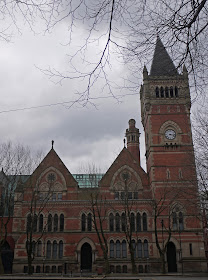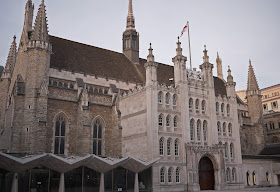The Midland Hotel
We were at a party in Cheshire yesterday and decided we would add on a trip to Manchester. This is a classic city walk for us: we both know Manchester reasonably well having been then for business, shopping etc., but the city walk offers the opportunity to approach it afresh and really see what is there.
I had, filed away, a walk around the centre of Manchester published in Walk magazine in Spring 2007 and we decided to use that as our basis. It starts from Piccadilly station and we found it easier to park at Manchester Central. This is the former Central station, the terminus for trains from St Pancras, now a conference centre. The brick arches of the car park are a fine sight.
We emerged opposite the Midland Hotel. It designed by Charles Trubshaw and constructed between 1898 and 1903 for the Midland Railway Company.
We decided to join our route at Princess St, so we continued along Lower Moseley St past the hotel to quickly reach the Manchester Central Library. This neo-classical building, presumably inspired by the Pantheon in Rome dates from 1930-4 and was designed by E Vincent Harris. It is currently being restored and will reopen next year. It is undeniably impressive and no doubt wonderful inside.
Next door is the Town Hall Extension, as downbeat a name as you possibly imagine. It is also by Harris and is supposedly an attempt to bridge the (literal) gap between the library and the Gothic revival Town Hall, which we come to next. It dates from 1934 and seems to me to involve a combination of Scandinavian influences, especially in the high pitched roof and dormer windows, and art deco in the relief sculptures on the gable ends. The lower parts of the building are perhaps a bit dull, but the top storey and the roof are very pleasing.
We turned left into Princess St and walked along the side of the Town Hall proper to emerge into Albert Square and the spectacular facade.
The architect was Alfred Waterhouse (perhaps principally famous for the Natural History Museum, although one could also mention the Prudential Building in Holborn, Reading School, Strangeways Prison and Liverpool University among many others) and completed in 1877.
In front is the Albert Memorial.
Other the right is a wonderful Venetian Gothic building which now houses a restaurant.
We walked down Brazennose St towards Deansgate and we delighted to see this fine statue of Abraham Lincoln, having just seen the new Spielberg film.
The statue was created by George Barnard and is a replica of one in Cincinnati, Ohio. It was one of two given to Britain in 1918 by Charles Taft the mayor of the city of Cincinnati and son of President W H Taft to celebrate 100 years of Anglo-American unity. Manchester claimed it on the strength of the well-known support of cotton workers there for the blockade of cotton from the slave states, which Lincoln wrote to acknowledge.
We were then drawn to a side street to see this red brick church.This is St Mary's which unusually advertises itself as "Manchester's hidden gem". This sounds like modern marketing speak, but its website suggests that this name dates back to 1872.
There has been a church here since 1794, but it had to be rebuilt in the late 1830s. Unfortunately for us, a service was in progress so we could see what was hidden within.
Reaching Deansgate we were confronted by the newly restored John Rylands Library, the library of the University of Manchester. It was opened in 1900 and was the work of Basil Champneys. Rylands was a textile millionaire and philanthropist and the library was his wife Enriqueta's memorial to him.
We walked along Dean St, noting the La Vina tapas bar as a promising place for lunch, and turned right to reach St Ann's Sq and the Cotton Exchange, now the Royal Exchange theatre. At one end of the square is the neo-classical St Ann's church of 1712, currently being restored.
One one side of the square is this lovely shop, which looks to have received a very good restoration, presumably by Barclay's. If so, well done to them.
The Royal Exchange itself isn't really that interesting a building, but I quite liked the corner clock and tower.
We walked along new Cathedral St to reach a surprising square at the end. The Old Wellington Inn directly ahead is the oldest building in Manchester, dating from 1552. The Oyster House to the right was rebuilt here following the rebuilding of the Arndale Centre. They make a lovely group.
Going through the square brings you to the Cathedral. Construction of a church on this site dates back to 1215, with major reconstruction in the late 15th century. The external stonework was renewed in the 19th century and there was further rebuilding after bomb damage in the second world war.
Round the back is Cathedral Gardens where the impressive Urbis building dominates one side of the open space. It was designed by Ian Simpson and completed in 2002. It now houses, appropriately enough, the national Football Museum.
We now walked along familiar and not especially interesting streets to Piccadilly station and up Fairfield St to Canal St. We walked behind this splendid Victorian building, and I went round to the front to take this picture, but I still don't know what it is.
Then along Canal Street. If you didn't know the character of this part of Manchester, with its many bars and clubs, some of the names - G A Y and Queer, for example - would soon give you a clue.
This brought us back to Princess St and an easy return to Manchester Central.
Conditions: grey and rather cold.
Distance: we walked about 4 miles.
Rating: four stars. Very interesting. I now feel I have a much better grip on the city is really like.

















































